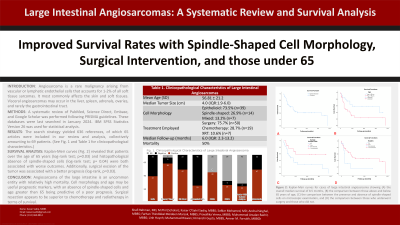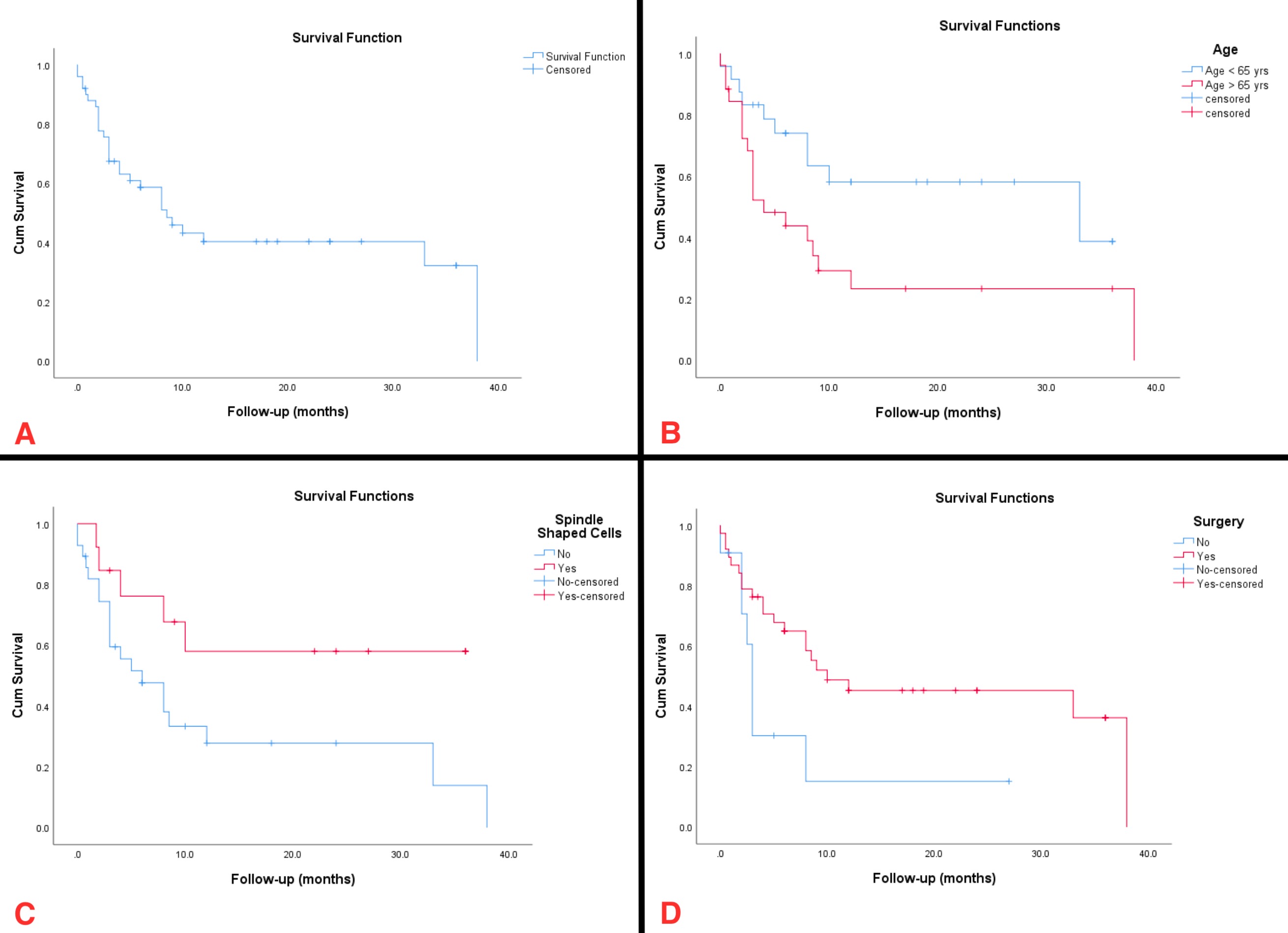Monday Poster Session
Category: Colon
P1953 - Improved Survival Rates in Large Intestinal Angiosarcomas With Spindle-Shaped Cell Morphology and Surgical Intervention: A Systematic Review and Survival Analysis
Monday, October 28, 2024
10:30 AM - 4:00 PM ET
Location: Exhibit Hall E

Has Audio

Kaiser O'Sahil Sadiq, MBBS
Plexus Neuro and Stem Cell Research Centre
Bangalore, Karnataka, India
Presenting Author(s)
Shafi Rehman, MD, M.Phil (Scholar)1, Kaiser O'Sahil. Sadiq, MBBS2, Safdar Mohamed, MD3, Anchal Singhal, MBBS4, Farhan Thindikkal. Moideen Marsok, MBBS5, Pravallika Venna, MBBS6, Muhammad Arsalan Bashir, MBBS7, Linh Huynh, 8, Muhammad Rizwan, 9, Himanshi Gupta, MBBS10, Ameer M. Farrukh, MBBCh11
1Khyber Medical University, Peshawar, North-West Frontier, Pakistan; 2Plexus Neuro and Stem Cell Research Centre, Bangalore, Karnataka, India; 3Nicolae Testemițanu State University of Medicine and Pharmacy, Chișinău, Chisinau, Moldova; 4Lady Hardinge Medical College, Surrey, BC, Canada; 5Tamil Nadu Dr. M.G.R. Medical University, Thrissur, Kerala, India; 6SVS Medical College, Hyderabad, Telangana, India; 7Ziauddin University, Karachi, Sindh, Pakistan; 8Kansas College of Osteopathic Medicine, Wichita, KS; 9Sheikh Zayed Medical College, Khanpur, Punjab, Pakistan; 10Lady Hardinge Medical College, New Delhi, Delhi, India; 11University of Galway, Watervliet, NY
Introduction: Angiosarcoma is a rare malignancy arising from vascular or lymphatic endothelial cells that accounts for 1-2% of all soft tissue sarcomas. It most commonly affects the skin and soft tissues. Visceral angiosarcomas may occur in the liver, spleen, adrenals, ovaries, and rarely the gastrointestinal tract.
Methods: A systematic review of PubMed, Science Direct, Embase, and Google Scholar was performed following PRISMA guidelines. These databases were last searched in January 2024. IBM SPSS Statistics Version 26 was used for statistical analysis.
Results: The search strategy yielded 636 references, of which 65 articles were included in our review and analysis, collectively amounting to 69 patients. 53.6% were male and the mean age at presentation was 56.81 ± 21.2 years. 56 (86.1%) were primary malignancies and 9 (13.8%) had metastasized to the large intestine. The median tumor size was 4.0 cm (IQR:1.9-6.0 cm). At presentation, 47/67 (70.1%) reported GI bleeding and 23/65 (35.3%) had abdominal pain. Angiosarcoma was detected in the colon (n=47), rectum (n=17), cecum (n=10), and appendix (n=2). Microscopic examination revealed pleomorphism in 25/54 (46.2 %) and mitotic figures in 23/55 (41.8 %). Cell morphology was spindle-shaped in 14/52 (26.9 %), epithelioid in 39/53 (73.5 %), and mixed in 7/53 (13.2 %). CD 31 was positive in 43/43 (100%), CD 34 in 24/30 (80%), and Factor VIII-related antigen in 22/26 (84.6%) patients. Metastasis was seen in 47/68 (69.1%) patients. Surgical excision was the most common treatment modality, performed in 50/66 (75.7%). 19/66 (28.7%) received chemotherapy and 7/66 (10.6%) received radiotherapy. Patients were followed up for a median of 6.0 months (IQR: 2.3-13.2 months). Mortality was 50%, and survival analysis using Kaplan-Meir curves revealed that patients over the age of 65 years (log-rank test; p=0.03) and histopathological absence of spindle-shaped cells (log-rank test; p= 0.04) were both associated with worse outcomes. Additionally, surgical excision of the tumor was associated with a better prognosis (log-rank, p=0.03).
Discussion: Angiosarcoma of the large intestine is an uncommon entity with relatively high mortality. Gastrointestinal bleeding represents the most common symptom. Cell morphology and age may be useful prognostic markers, with an absence of spindle-shaped cells and age greater than 65 being predictive of a poor prognosis. Surgical resection appears to be superior to chemotherapy and radiotherapy in terms of survival.

Disclosures:
Shafi Rehman, MD, M.Phil (Scholar)1, Kaiser O'Sahil. Sadiq, MBBS2, Safdar Mohamed, MD3, Anchal Singhal, MBBS4, Farhan Thindikkal. Moideen Marsok, MBBS5, Pravallika Venna, MBBS6, Muhammad Arsalan Bashir, MBBS7, Linh Huynh, 8, Muhammad Rizwan, 9, Himanshi Gupta, MBBS10, Ameer M. Farrukh, MBBCh11. P1953 - Improved Survival Rates in Large Intestinal Angiosarcomas With Spindle-Shaped Cell Morphology and Surgical Intervention: A Systematic Review and Survival Analysis, ACG 2024 Annual Scientific Meeting Abstracts. Philadelphia, PA: American College of Gastroenterology.
1Khyber Medical University, Peshawar, North-West Frontier, Pakistan; 2Plexus Neuro and Stem Cell Research Centre, Bangalore, Karnataka, India; 3Nicolae Testemițanu State University of Medicine and Pharmacy, Chișinău, Chisinau, Moldova; 4Lady Hardinge Medical College, Surrey, BC, Canada; 5Tamil Nadu Dr. M.G.R. Medical University, Thrissur, Kerala, India; 6SVS Medical College, Hyderabad, Telangana, India; 7Ziauddin University, Karachi, Sindh, Pakistan; 8Kansas College of Osteopathic Medicine, Wichita, KS; 9Sheikh Zayed Medical College, Khanpur, Punjab, Pakistan; 10Lady Hardinge Medical College, New Delhi, Delhi, India; 11University of Galway, Watervliet, NY
Introduction: Angiosarcoma is a rare malignancy arising from vascular or lymphatic endothelial cells that accounts for 1-2% of all soft tissue sarcomas. It most commonly affects the skin and soft tissues. Visceral angiosarcomas may occur in the liver, spleen, adrenals, ovaries, and rarely the gastrointestinal tract.
Methods: A systematic review of PubMed, Science Direct, Embase, and Google Scholar was performed following PRISMA guidelines. These databases were last searched in January 2024. IBM SPSS Statistics Version 26 was used for statistical analysis.
Results: The search strategy yielded 636 references, of which 65 articles were included in our review and analysis, collectively amounting to 69 patients. 53.6% were male and the mean age at presentation was 56.81 ± 21.2 years. 56 (86.1%) were primary malignancies and 9 (13.8%) had metastasized to the large intestine. The median tumor size was 4.0 cm (IQR:1.9-6.0 cm). At presentation, 47/67 (70.1%) reported GI bleeding and 23/65 (35.3%) had abdominal pain. Angiosarcoma was detected in the colon (n=47), rectum (n=17), cecum (n=10), and appendix (n=2). Microscopic examination revealed pleomorphism in 25/54 (46.2 %) and mitotic figures in 23/55 (41.8 %). Cell morphology was spindle-shaped in 14/52 (26.9 %), epithelioid in 39/53 (73.5 %), and mixed in 7/53 (13.2 %). CD 31 was positive in 43/43 (100%), CD 34 in 24/30 (80%), and Factor VIII-related antigen in 22/26 (84.6%) patients. Metastasis was seen in 47/68 (69.1%) patients. Surgical excision was the most common treatment modality, performed in 50/66 (75.7%). 19/66 (28.7%) received chemotherapy and 7/66 (10.6%) received radiotherapy. Patients were followed up for a median of 6.0 months (IQR: 2.3-13.2 months). Mortality was 50%, and survival analysis using Kaplan-Meir curves revealed that patients over the age of 65 years (log-rank test; p=0.03) and histopathological absence of spindle-shaped cells (log-rank test; p= 0.04) were both associated with worse outcomes. Additionally, surgical excision of the tumor was associated with a better prognosis (log-rank, p=0.03).
Discussion: Angiosarcoma of the large intestine is an uncommon entity with relatively high mortality. Gastrointestinal bleeding represents the most common symptom. Cell morphology and age may be useful prognostic markers, with an absence of spindle-shaped cells and age greater than 65 being predictive of a poor prognosis. Surgical resection appears to be superior to chemotherapy and radiotherapy in terms of survival.

Figure: Figure 1: Kaplan-Meir curves for cases of large intestinal angiosarcoma showing (A) the overall median survival of 8.5 months, (B) the comparison between those above and below 65 years of age, (C) the comparison between the presence and absence of spindle-shaped cells on microscopic examination, and (D) the comparison between those who underwent surgery and those who did not.
Disclosures:
Shafi Rehman indicated no relevant financial relationships.
Kaiser Sadiq indicated no relevant financial relationships.
Safdar Mohamed indicated no relevant financial relationships.
Anchal Singhal indicated no relevant financial relationships.
Farhan Moideen Marsok indicated no relevant financial relationships.
Pravallika Venna indicated no relevant financial relationships.
Muhammad Arsalan Bashir indicated no relevant financial relationships.
Linh Huynh indicated no relevant financial relationships.
Muhammad Rizwan indicated no relevant financial relationships.
Himanshi Gupta indicated no relevant financial relationships.
Ameer Farrukh indicated no relevant financial relationships.
Shafi Rehman, MD, M.Phil (Scholar)1, Kaiser O'Sahil. Sadiq, MBBS2, Safdar Mohamed, MD3, Anchal Singhal, MBBS4, Farhan Thindikkal. Moideen Marsok, MBBS5, Pravallika Venna, MBBS6, Muhammad Arsalan Bashir, MBBS7, Linh Huynh, 8, Muhammad Rizwan, 9, Himanshi Gupta, MBBS10, Ameer M. Farrukh, MBBCh11. P1953 - Improved Survival Rates in Large Intestinal Angiosarcomas With Spindle-Shaped Cell Morphology and Surgical Intervention: A Systematic Review and Survival Analysis, ACG 2024 Annual Scientific Meeting Abstracts. Philadelphia, PA: American College of Gastroenterology.
